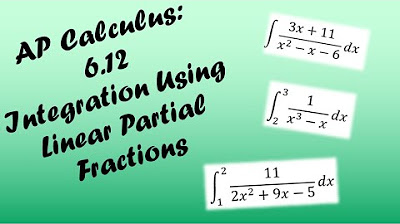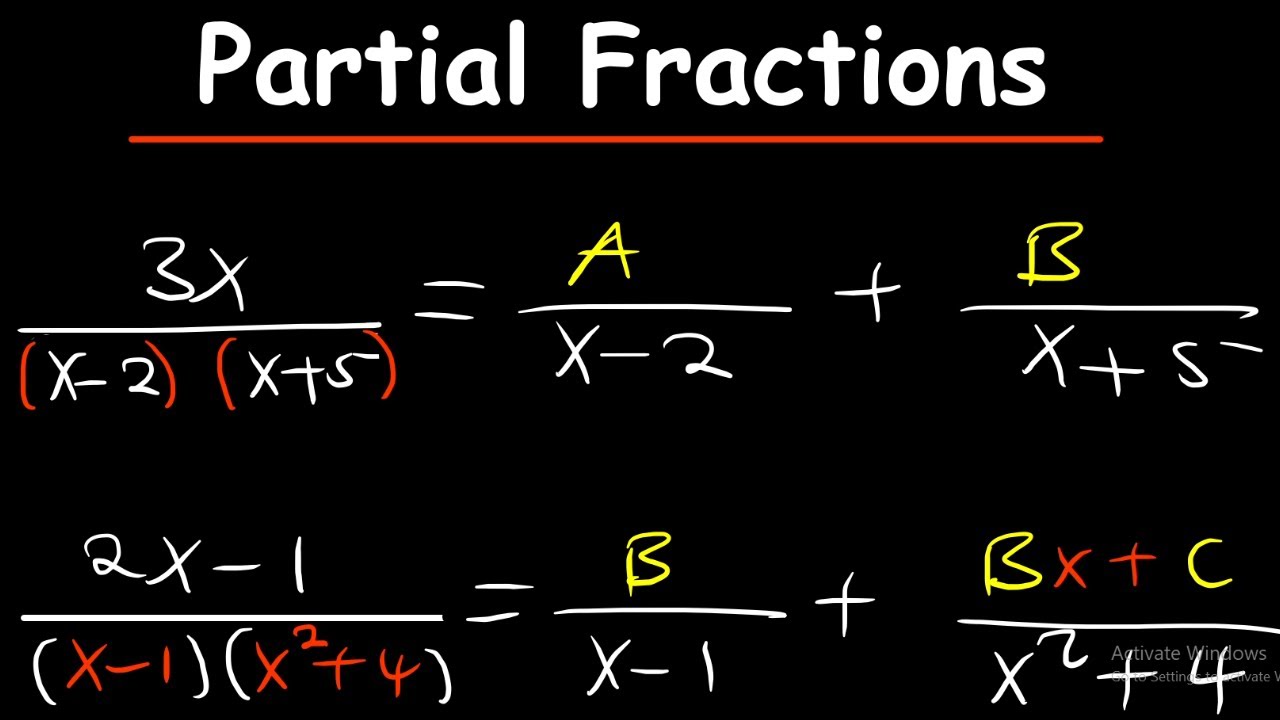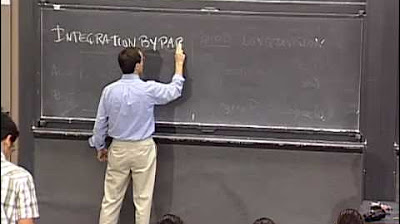Calculus Chapter 3 Lecture 24 Partial Fractions
TLDRIn this calculus lecture, Professor Greist introduces the method of partial fractions, an algebraic simplification technique for integrating rational functions with distinct real roots. Through examples, the professor demonstrates how to decompose integrands into simpler fractions and solve for constants using direct substitution. The lecture also touches on the application of partial fractions in differential equations, such as modeling a beam's deflection, and highlights the importance of roots in various mathematical contexts.
Takeaways
- 📚 The lecture introduces the method of partial fractions, a technique for integrating rational functions by algebraic simplification.
- 🔍 Partial fractions are used when the degree of the denominator is greater than the degree of the numerator and the denominator has distinct real roots.
- 📝 The script demonstrates how to decompose a rational function into a sum of simpler fractions, facilitating easier integration.
- 🔑 An example is provided to illustrate the process of determining the constants in the partial fraction decomposition, using a system of linear equations.
- 📈 The lecture also covers a direct method for finding constants by substitution, which simplifies the process of expanding and collecting like terms.
- 📚 The integral of a rational function can be expressed as a sum of logarithmic functions once decomposed into partial fractions.
- 🔧 The method of partial fractions is applied to solve a differential equation modeling the deflection of a beam under a constant force.
- 🔄 The roots of the denominator play a crucial role in the partial fraction decomposition, with real, distinct roots simplifying the process.
- ⚠️ The script notes that complications arise with repeated or complex roots, which require more involved algebraic manipulation.
- 📉 The lecture touches on the physical interpretation of roots in differential equations, such as in the model of a buckling beam.
- 🚫 The method's limitations are acknowledged, particularly with complex roots, and it is stated that these more complicated cases will not be tested in the course.
Q & A
What is the main topic of lecture 24 by Professor Greist?
-The main topic of lecture 24 is the method of partial fractions, an algebraic simplification technique used for integrating rational functions.
Why is the method of partial fractions useful in calculus?
-The method of partial fractions is useful because it simplifies the process of integrating rational functions by breaking them down into simpler components that are easier to integrate.
What is the algebraic result that Professor Greist refers to for rational functions with a degree of the denominator greater than the degree of the numerator?
-The algebraic result is that such a rational function can be decomposed into a sum of simpler fractions where each term is a constant over a factor of the denominator.
How does the method of partial fractions simplify the integration of the function 3x^2 - 5 over x - 2?
-By performing polynomial division, the function is simplified to 3x + 6 with a remainder of 7 over x - 2, making the integrals of 3x and 7/(x - 2) straightforward to compute.
What is the process for determining the constants (a sub i) in the partial fraction decomposition?
-The constants are determined by multiplying out the right-hand side of the decomposition, equating it to the original function, and solving the resulting system of linear equations for the unknown constants.
Why does Professor Greist suggest using a direct method for computing constants a and b in the example given?
-The direct method simplifies the process by substituting specific values of x that eliminate certain variables, making it easier to solve for the constants without expanding and collecting terms.
How does the lecture demonstrate the application of partial fractions in solving a differential equation related to a thin beam?
-The lecture shows how to factor the differential equation and then apply the separation method, which leads to the use of partial fractions to integrate both sides of the equation.
What is the significance of the roots in the context of partial fractions and differential equations?
-The roots are significant because they control the form of the partial fraction decomposition and have physical interpretations in differential equation models, affecting the stability and behavior of the system.
What complications arise when applying the method of partial fractions to functions with repeated or complex roots?
-Repeated roots require a more complicated decomposition with terms involving powers of (x - r), while complex roots involve a linear polynomial in the numerator and a quadratic in the denominator, making the integration process more cumbersome.
How does the lecture conclude regarding the method of partial fractions and the study of calculus?
-The lecture concludes by emphasizing that while algebraic methods like partial fractions can be incredibly helpful, they can also be complex. It suggests that the focus will shift to definite integrals rather than further exploring these complex integration techniques.
Outlines
📚 Introduction to Partial Fractions
Professor Greist begins Lecture 24 by introducing the method of partial fractions, a technique used for integrating rational functions with a polynomial in the denominator of higher degree than the numerator. The lecture explains how this method simplifies the integration process by breaking down complex integrands into simpler components that can be easily integrated. The professor uses the example of integrating 3x^2 - 5 over x - 2, demonstrating the simplification process and the algebraic result that allows the decomposition of a rational function into a sum of constants over linear factors.
🔍 Determining Coefficients in Partial Fractions
This section delves into the process of determining the constants, known as 'a sub I', in the partial fraction decomposition. The professor illustrates this with the example of simplifying 3x - 1 over x^2 - 5x - 6, factoring the denominator and setting up the equation to solve for the constants 'a' and 'B'. The method involves equating coefficients from the expanded form to those of the original numerator, resulting in a system of linear equations. The professor also introduces a more direct method for finding 'a' and 'B' by substituting specific values of x that simplify the equation, allowing for the quick determination of the constants.
📘 Application of Partial Fractions in Integration
The third paragraph discusses the application of partial fractions in solving integrals, using the integral of x^2 + 2x - 1 over 2x^3 + 3x^2 - 2x as an example. The professor shows the process of factoring the denominator and setting up the partial fraction decomposition with three unknown constants. By strategically substituting values for x, the constants are determined, and the integral is simplified into a sum of logarithmic functions. This method is then applied to a differential equation modeling the deflection of a beam under a constant force, demonstrating the practical use of partial fractions in solving real-world problems.
🔬 Complexities and Limitations of Partial Fractions
The final paragraph addresses the potential complexities and limitations of the partial fraction method, particularly when dealing with repeated or complex roots. The professor explains that while the method is powerful, it can become cumbersome in cases where the roots are not distinct real numbers. The lecture also touches on the importance of roots in various mathematical contexts, including differential equations and linear algebra, emphasizing their significance in understanding the behavior of mathematical models. The professor concludes by highlighting the importance of roots and the need to be attentive to their properties when solving integrals and differential equations.
Mindmap
Keywords
💡Partial Fractions
💡Integrand
💡Polynomial Division
💡Rational Function
💡Algebraic Simplification
💡Decomposition
💡Differential Equations
💡Deflection
💡Equilibrium
💡Roots
Highlights
Introduction to the method of partial fractions for integrating rational functions.
Change of perspective from differentiation rules to algebraic simplification in calculus.
Simplification of integrands through pre-processing steps, especially for rational functions.
Example of polynomial division to simplify the integral of 3x^2 - 5 over x - 2.
Explanation of the algebraic result for decomposing rational functions with distinct real roots.
Method of partial fractions simplifies the integration of complex rational functions.
Direct method for determining constants in partial fraction decomposition through substitution.
Solving a system of linear equations to find constants a and b in the example of 3x - 1 over x^2 - 5x - 6.
Application of partial fractions to the integral of x^2 + 2x - 1 over 2x^3 + 3x^2 - 2x.
Use of substitution to find coefficients a, b, and c in the integral example.
Integration resulting in logarithmic functions after applying partial fractions.
Application of partial fractions in solving a differential equation modeling a thin beam's deflection.
Identification of equilibrium points and their stability in the context of a differential equation.
Discussion of complications with partial fractions when dealing with repeated or complex roots.
Emphasis on the importance of roots in calculus, differential equations, and linear algebra.
Introduction of the definite integral as the next topic in the calculus lecture series.
Transcripts
Browse More Related Video

Unit VI: Lec 2 | MIT Calculus Revisited: Single Variable Calculus

Lec 29 | MIT 18.01 Single Variable Calculus, Fall 2007

AP Calculus BC Lesson 6.12

Partial Fractions Decomposition simplified

Lec 30 | MIT 18.01 Single Variable Calculus, Fall 2007

Using Partial Fractions in Differential Equations (Differential Equations 34)
5.0 / 5 (0 votes)
Thanks for rating: